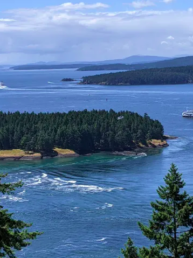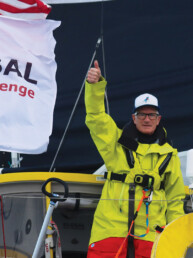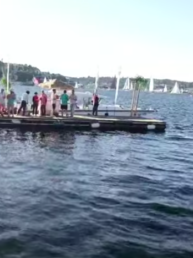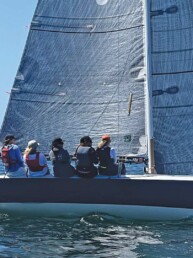Lessons learned from years of cruising about onboard gear and how it runs its natural course.
What do galley stoves, outboard engines, and winch handles have in common? They’re all sold at boat shows, and they all sink if given the chance. A Totem winch handle proved this when I fumbled it while we sailed 100 miles east of Brazil. A neighbor in Suwarrow atoll found that outboards sink; this float test fail in a remote, deep water anchorage made them very sad. Sinking stoves is not yet verified but frustration caused by our rapidly failing stove may expedite its float test. We bought this stove new in 2008. The notion of replacing this again is annoying. The flip side is that it’s heated roughly 12,000 meals. Full-time cruising is hard on a boat, as reflected in the long list of worn-out bits we’ve replaced on Totem over the years.

For context: in 2007 we purchased a 1982 Stevens 47 named Don’t Look Back that we renamed Totem. In 2008 we moved aboard with our three children and began full-time cruising. In 2018 our oldest, Niall, moved off to college; his sisters Mairen and Siobhan remain aboard. This all equates to mostly five people living and traveling on Totem for roughly 4,500 days and 65,000 miles.
The hull, deck, mast, boom, bulkheads, and other core components are original. Much of the rest is not. Beginning with thru hull assemblies in 2007, most of the 11 were bronze originals. We’ve since eliminated five and replaced the others when they showed signs of dezincification (indicated by a pinkish tint). The port lights are original, but we did replace all eight deck hatches in 2019 (Mexico). Lifeline stanchions and pulpits are original, but all of their bases and 6 deck cleats were replaced in 2014 (Thailand). Failed stainless steel is a common feature on this list.
Standing rigging integrity is fundamental on a cruising sailboat. We replaced it all (including tangs, tang bolts, etc.), except turnbuckles in 2008 (Port Townsend) and again including turnbuckles in 2019 (Mexico). We also replaced much running rigging in 2008, excepting a Vectran/ Polyester doublebraid main halyard and mainsheet. They looked ok enough to get another year or two and they actually lasted another eight years, until 2016 (South Africa). Main reefing lines and asymmetric halyard were replaced a second time in 2014 (Malaysia) due to chafe.
I don’t have all sailing hardware replacement logged. There were small items like plastic sheave and block parts degraded from UV exposure. Mostly though, more stainless steel failures that left us with exciting moments. Like the boom pad eye that sheared off from the mainsheet block, a genoa sheet car link (Garhaur replaced this, stating it was faulty design), and three broken snap shackles. We have since switched to Dyneema loops and soft shackles where possible, and don’t have a single failure to report. Totem’s Profurl headsail furler was new around 2002 and mostly reliable. Preventative bearing replacement in 2008 kept it spinning well until the furler exploded without warning in 2017 (Martinique). Installed a new bearing set and the furler furls well still. Another exploded part was a Harken high load snatch block used to lead the barber-hauler. Light air and lumpy seas sailing to Marquesas proved that light air shock loads can exceed high load engineering. Our biggest sailing hardware replacement was winches. The original 1982 Barients, first generation self-tailing winches, served well until becoming unserviceable any longer. The new Anderson self-tailing winches — secondaries replaced in 2018, primaries in 2019 — are glorious!
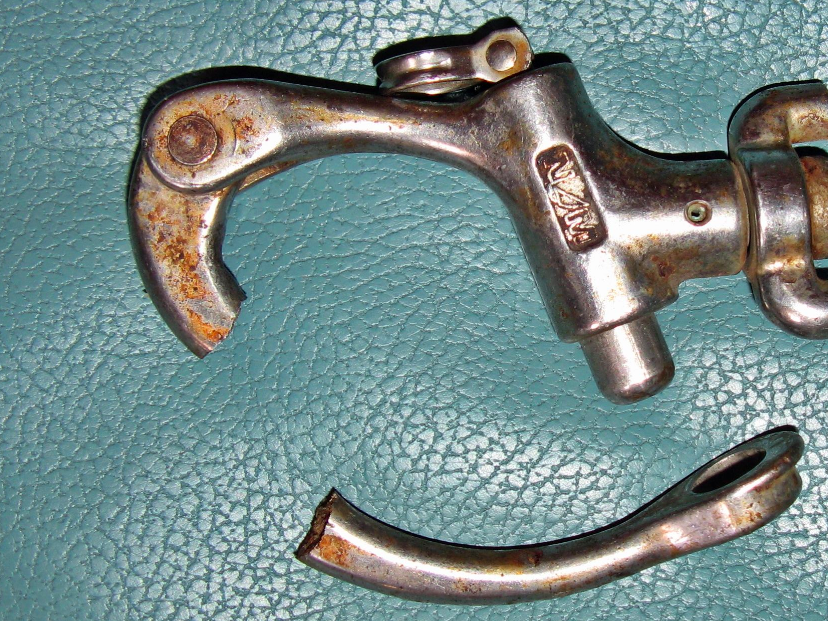
Sails aboard Totem at our purchase in 2008 were under built and had just finished a Pacific loop. As a frugal sailmaker, I was able to reinforce them, hoping to gain an extra year or two. The mainsail reached 2012 (Australia). That replacement succumbed to UV degrading the sailcloth and was replaced in 2019 (Mexico). The original genoa made it to 2014 (Malaysia). Its replacement is still in use, but won’t be with us when we sail west from North America post-Covid. We added an asymmetric in 2008 which remains in good condition. Our storm staysail is folded tightly and stored under the V-berth, with only three hours of use. Lastly our so called “Iron Genny”, a 2002 75 hp Yanmar 4JH3-TE, is still in service. Both pumps were replaced in 2014, as was the heat exchanger assembly in 2017 (Martinique). We replaced the prop in 2007, an ill-matched prior owner mistake, with a Flex-o-Fold that is exceptional. And finally, the prop shaft whose age was unknown was retired in 2018 (Mexico) due to wear.
Steering is best when reliable. To ensure this I replaced the cables in 2008 along with servicing sheaves and other components. In 2014, I replaced the eyebolt linking cables to quadrant after one failed underway. In 2018 (Colombia) the last link on the steering chain failed. The material for both of these failures? Stainless steel… I’d inspected the chain just several months before, but failed to identify hairline fracture. Both moments of unreliable steering, due to stainless steel failure, were solved with…? Dyneema, again.
In the safety category, we replaced most items before setting off, including offshore life raft, EPIRB, fire extinguishers, signaling devices, tethers, PFDs, lifelines (Dyneema), ditch kit and first aid kits ready for business we hoped never to need. PFDs, signaling device, and other short-lived items were replaced along the way. EPIRB battery expired in 2012 (Australia). It still tested ok, so we kept it while adding a new one then and another one 2018 (Annapolis). In 2019 (Mexico) we purchased a new offshore life raft and replaced Dyneema lifelines with…? More Dyneema!
Time to mention stainless steel again? In 2014 the last remaining stainless tank water was weeping to the point of being unrepairable, and thus removed and replaced. I built the new one with fiberglass and epoxy, increasing capacity by 50-percent. During that same haulout, I also built a new refrigeration box. Amazing what a difference good insulation (not saturated with water!) makes. Insulated hot water tank was leaking in 2008. We replaced it with an Isotherm tank in 2008. This went for 12 years until beginning to leak and was replaced again in 2020. On the subject of water, watermakers! The “working” but pickled watermaker that came with Totem didn’t actually work once unpickled. So off it went, replaced by a small Spectra unit. That unit made it around the world with us, but we didn’t shed tears when replacing it in 2019 with a glorious 30 gallon per hour CruiseRO watermaker.
The less glorious black water system on Totem never passed the sniff test, is somehow just never bubbled up to top our early refit list. Crossing the Pacific, we found the half inch vent hose clogged with tank contents. Then vacuum pressure tried to implode the tank when we sought to pump out. It didn’t rupture, but in 2011 (Australia) the need for a new waste system was a priority. New tank, diaphragm waste pump, and hoses, including 1-1/2-inch vent hose were a breath of fresh air. Upstream of the holding tank are toilets. The electric Vacuflush and manual Lavac both made it around, though I wish the latter one had never started the trip. We replaced it in 2019 with an electric Tecma unit that makes an elegant, efficient, trouble-free throne.
Energy systems were maintained, replaced, and upgraded. Pre-departure improvements included a new 660 amp hour AGM battery bank, AirBreeze Wind turbine, and MPPT charge controller for solar panels totaling 300 watts. Batteries were replaced again in 2014 (Malaysia) with capacity increased to 1020 amp hours. Capacity increase served us well, but the local market lowered our options for quality replacements. The bank needed replacement again in 2017 (Florida). In 2013 we replaced the loud, low output wind turbine with a much better SilentWind. In 2014, two of four solar panels were swapped for one large, more efficient one. Four years later, we replaced all panels with two big ones with the same footprint as the original panels, but more than double the output at 630 watts. This required a new MPPT charge controller. We began our journey with a big inverter charger, which died in 2013. Its replacement died a year later in Malaysia due to bad dock power (which the marina replaced). The inverter portion worked until 2017 (Barbados). We got by with a small replacement until 2019, then installed a new Victron Multiplus II 3,000 watt inverter charger capable of running the AC watermaker if the Honda 2200i gas generator failed. It’s our third gas generator, so prudent to have redundant ways to power the watermaker.
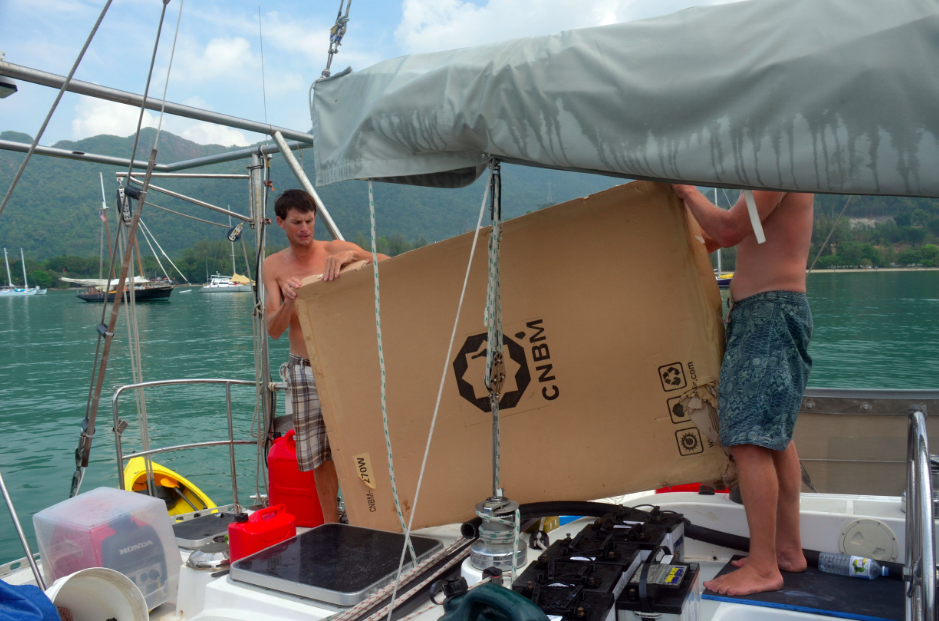
Electronics fared better than then energy devices. Everything but autopilot, radar, and SSB was upgraded. But two days prior to cutting the docklines, autopilot electronics failed and was added to the list of new items aboard. The 1993 Raytheon linear autopilot drive unit may have circumnavigated twice now, and is still aboard Totem. The Furuno SSB died twice crossing the Pacific, apparently not up to the continuous demand of being used with a Pactor modem. In 2012 (Australia) that SSB was sold and replaced with a new Icom M802, along and with the ancient Raytheon radar. From another cruiser we bought a much newer Raymarine color radar that consumed much less power. Unfortunately, an indirect lightning strike while anchored near a volcano in 2013 (Indonesia), scrambled it. The next year without radar in squally southeast Asia was exciting enough that a new Garmin radar was very welcome aboard.
Not strictly part of Totem, but dinghies deserve a mention. For full-time, year-round cruisers, dinghy and outboard are like the family SUV. We began our journey with a 1994 Avon RIB and 15 hp Mercury outboard. The outboard blew a head gasket in 2010 (Bora Bora). We borrowed a small outboard for the remained of the trip, and gained deep appreciation for the value of dinghy mobility. At a boat show in Australia, we got a nice deal on Tohatsu 18 hp and 3.5 hp spare. The dinghy was 19 years old, in 2013, when a friend stepping on put his foot through the Hypalon tube. Its replacement was a new aluminum bottom RIB that left us wanting the old one back. Riding at speed was squirrely and it wore so easily that when opportunity to get discounted “last year’s model” AB RIB with bow locker in 2017 (BVIs) we didn’t hesitate. The bow locker is nice feature and the ride excellent. Last year, the Tohatsu 18 hp continued to run very well, but degrading alloy mounting brackets and lower unit meant it was worn out and no longer reliable enough. The new Yamaha 15 hp is better built, but lacks the power of the 18 hp.
It’s a ridiculous list. But it’s grounded in reality that long term cruising on boats with stainless steel, electrical devices, and other gear are faults waiting to happen. Grounded, wait – I forgot ground tackle! We’ve replaced the windlass motor once, somewhere. We’ve anchored 712 times with the same 33 kg Rocna we bought in 2008 and anchor chain that was already aboard. The anchor chain has been re-galvanized four times along the way. Being at anchor most of the year we deeply value anchor gear integrity, so when the galvanizing wears this time we’ll be ready to replace the chain. New G40 chain is stronger and lighter than our current BBB chain, but requires a new gypsy on the windlass to fit it.
No, it never ends.
Some maintain that keeping cruising boats simpler is the best way. If that’s your way, good for you. I’d rather a cool drink when the sun goes down, a dinghy with speed enough for exploration, and unquestionably reliable systems. Some of the replacements mentioned were due to poor choices. Others due to poor quality. But overwhelmingly, it’s lifespan: replacing because it simply got used, like the stove that’s cooked 12,000 meals.
Time to put on the kettle for a cuppa and review marine stoves.
Behan and Jamie Gifford
Behan and Jamie Gifford set sail from Bainbridge Island in 2008 and are currently aboard Totem in Mexico. Their column for 48° North has traced Lessons Learned Cruising during a circumnavigation with their three children aboard and continued adventures afloat. Follow them at www.sailingtotem.com

